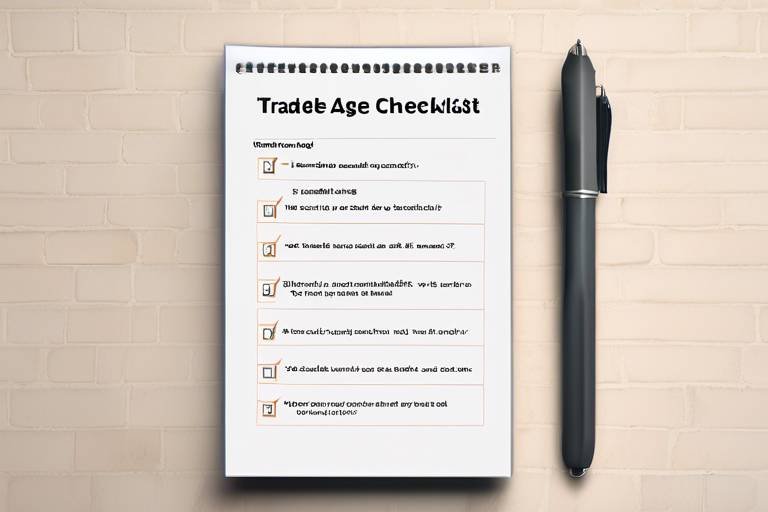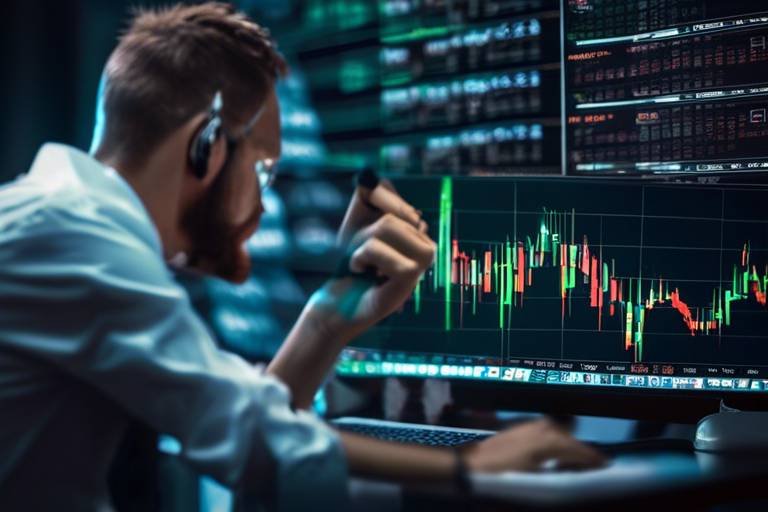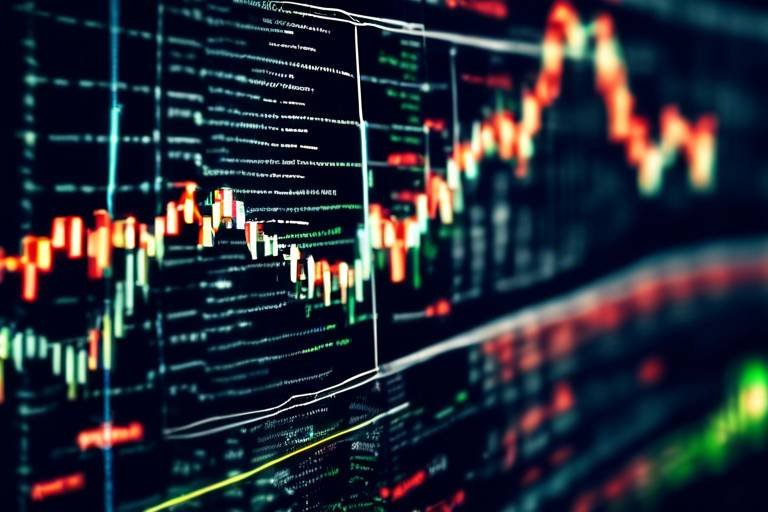The Best Tools for Crypto Technical Analysis
In the fast-paced world of cryptocurrency trading, having the right tools for technical analysis can be the difference between making a profit and facing a loss. With prices that can swing wildly in just a matter of hours, traders need to equip themselves with robust resources to analyze market trends effectively. This article delves into an array of essential tools that can help traders navigate the complex waters of the crypto market, ensuring they make informed decisions and optimize their strategies. Whether you are a seasoned trader or just starting, understanding these tools will enhance your trading experience and boost your confidence.
Charting software is a fundamental component for any trader looking to visualize price movements and identify patterns in the market. These tools enable traders to see historical data and make predictions based on past performance. Popular charting tools like TradingView, Coinigy, and CryptoCompare provide comprehensive features such as customizable charts, various time frames, and multiple indicators. With these tools, traders can easily spot trends, reversals, and potential breakout points, which are crucial for making timely trading decisions. The ability to overlay different indicators and compare multiple cryptocurrencies simultaneously can significantly enhance a trader's analytical capabilities.
Indicators are the bread and butter of technical analysis, helping traders to assess market trends and signals. They provide insights into market momentum, volatility, and potential price reversals. By utilizing various indicator tools, traders can enhance their trading strategies and improve their decision-making processes. Some of the most popular indicators include Moving Averages, Relative Strength Index (RSI), and Bollinger Bands. Each of these tools serves a unique purpose, allowing traders to analyze price movements from different perspectives. For instance, while moving averages can help identify trends, the RSI can indicate whether a market is overbought or oversold, providing crucial signals for potential entry or exit points.
Moving averages are one of the most widely used tools in technical analysis, smoothing out price data to help identify trends over specific periods. They are particularly useful in determining the overall direction of a market, whether it's bullish or bearish. Traders often use two main types of moving averages: Simple Moving Average (SMA) and Exponential Moving Average (EMA). Each has its own unique characteristics and applications in trading, making them essential for any trader's toolkit.
The Simple Moving Average (SMA) is a straightforward yet powerful tool for trend analysis. It calculates the average price of a cryptocurrency over a specified number of periods, offering a clear view of the market direction. For example, a 50-day SMA can help traders identify whether the price is trending upwards or downwards over the last 50 days. The significance of the SMA lies in its ability to filter out the noise from random price fluctuations, allowing traders to focus on the overall trend. However, it is essential to remember that the SMA can lag behind the price action, which may lead to delayed signals.
On the other hand, the Exponential Moving Average (EMA) gives more weight to recent prices, making it more responsive to new information. This characteristic allows traders to spot trends more quickly than with the SMA. The EMA is particularly useful in volatile markets like cryptocurrencies, where rapid price changes are common. By using the EMA, traders can make quicker decisions based on the most relevant data, enhancing their overall trading strategy. Whether you're looking to enter a trade or exit one, understanding how to use the EMA effectively can significantly impact your trading success.
Momentum indicators play a crucial role in assessing the strength of a price movement. These tools help traders gauge whether a trend is likely to continue or reverse, providing valuable insights into market dynamics. Popular momentum indicators include the Relative Strength Index (RSI) and the Moving Average Convergence Divergence (MACD). By incorporating these indicators into their trading strategies, traders can make more informed decisions about when to enter or exit positions, ultimately improving their chances of success in the ever-changing crypto landscape.
For traders looking to automate their buying and selling processes, trading bots are an invaluable resource. These automated systems operate based on predefined strategies, allowing traders to take advantage of market opportunities without the need for constant monitoring. Various trading bots are available for crypto enthusiasts, each offering unique features and benefits. Some popular options include 3Commas, Cryptohopper, and HaasOnline. By utilizing trading bots, traders can execute their strategies more efficiently, reduce emotional decision-making, and capitalize on market movements even when they are not actively trading.
Algorithmic trading takes automation a step further by using complex algorithms to make trades based on specific criteria. This method allows traders to analyze vast amounts of data quickly and execute trades at optimal prices. By leveraging algorithmic strategies, traders can enhance their performance in the crypto market, making data-driven decisions that minimize risks and maximize profits. However, it's essential to understand the algorithms being used, as poorly designed strategies can lead to significant losses.
Backtesting tools are vital for any trader looking to refine their strategies and minimize risks. These tools allow traders to test their strategies against historical data, providing insights into how a particular approach would have performed in the past. By analyzing the results of backtesting, traders can identify strengths and weaknesses in their strategies, making necessary adjustments before risking real capital. This process not only builds confidence but also helps traders develop a more robust trading plan tailored to their unique goals.
- What is the best charting software for crypto trading? - Popular options include TradingView and Coinigy, which offer comprehensive features for technical analysis.
- How do moving averages help in trading? - Moving averages smooth out price data, helping traders identify trends and make informed decisions.
- Are trading bots effective? - Yes, trading bots can automate trading strategies and help traders capitalize on market opportunities without constant monitoring.
- What is the importance of backtesting? - Backtesting allows traders to evaluate their strategies against historical data, helping to refine approaches and minimize risks.

Charting Software
When diving into the world of cryptocurrency trading, one of the first things you’ll notice is the sheer importance of . This is not just a fancy tool; it’s your digital compass, guiding you through the often turbulent waters of the crypto market. Imagine trying to navigate a ship without a map or compass—pretty daunting, right? That’s exactly how traders feel without the right charting tools. They help visualize price movements and identify patterns, which are crucial for making informed trading decisions.
Several popular charting tools have emerged, each offering unique features tailored to the needs of crypto traders. For instance, platforms like TradingView, Coinigy, and CryptoCompare stand out for their user-friendly interfaces and comprehensive analytical capabilities. They provide a plethora of indicators, drawing tools, and customizable settings that allow traders to tailor their analysis to their specific strategies.
What’s more, these tools often come with social features that enable traders to share insights and strategies with one another. This community aspect can be incredibly beneficial, as it allows you to learn from others’ experiences and refine your own trading techniques. For example, you might find a trader who has successfully utilized a particular chart pattern that you hadn’t considered before.
Let’s break down some essential features you should look for in charting software:
- Real-time Data: The ability to view live price changes is crucial for making timely decisions.
- Multiple Time Frames: Access to different time frames (e.g., daily, hourly, minute) helps in understanding both long-term trends and short-term fluctuations.
- Customizable Indicators: The ability to add and modify indicators to suit your trading style is invaluable.
- Chart Patterns: Look for software that helps identify traditional chart patterns like triangles, flags, and head and shoulders.
By utilizing these features, traders can create a more comprehensive view of market dynamics, which is essential for crafting effective trading strategies. However, it's not just about having the tools; it's about knowing how to use them effectively. Many traders spend hours analyzing charts, trying to decipher the clues that price movements provide. This can be likened to piecing together a puzzle; each indicator and chart pattern is a piece of the bigger picture, and when they come together, they can reveal critical insights.
In summary, investing time in choosing the right charting software can significantly enhance your trading experience. It’s not just a matter of convenience; it’s about arming yourself with the best tools to navigate the complex world of cryptocurrency. So, whether you’re a seasoned trader or just starting, make sure to explore the various charting options available to you. The right software could very well be the key to unlocking your trading potential.

Indicator Tools
When it comes to navigating the choppy waters of the cryptocurrency market, having the right at your disposal can make all the difference. These tools are like your trusty compass, guiding you through the stormy seas of price fluctuations and market volatility. By analyzing trends and signals, indicator tools help traders make informed decisions that can lead to profitable outcomes. Whether you're a seasoned pro or just dipping your toes into the world of crypto, understanding and utilizing these indicators is essential for optimizing your trading strategies.
One of the most appealing aspects of indicator tools is their ability to distill complex market data into actionable insights. Imagine trying to read a map with too many details—it can be overwhelming! Indicator tools simplify this process, allowing you to focus on what really matters. They can highlight potential entry and exit points, show the strength of a trend, and even alert you to possible reversals. With the right set of indicators, you can enhance your trading decisions and boost your chances of success in this fast-paced environment.
Now, let’s dive into some of the most popular types of indicator tools that are widely used by crypto traders:
- Moving Averages: These indicators help smooth out price data, making it easier to identify trends over time.
- Momentum Indicators: These tools assess the strength of price movements, helping traders determine whether to buy or sell.
- Volume Indicators: Understanding trading volume can provide insights into the strength of a price move.
Each of these indicators serves a unique purpose and can be utilized in different trading strategies. For instance, moving averages are particularly useful for identifying long-term trends, while momentum indicators can signal potential reversals. By combining these tools, traders can create a robust trading strategy that adapts to changing market conditions.
To give you a clearer picture of how these indicators can be applied, let’s take a closer look at two key types of indicators: Moving Averages and Momentum Indicators.
Moving averages are fundamental to technical analysis in the crypto space. They act as a filter for market noise, allowing traders to see the underlying trend more clearly. There are two primary types of moving averages that traders often use: the Simple Moving Average (SMA) and the Exponential Moving Average (EMA). Each has its own unique characteristics and applications in trading.
| Type | Description | Use Case |
|---|---|---|
| Simple Moving Average (SMA) | Calculates the average price over a set number of periods. | Best for identifying long-term trends. |
| Exponential Moving Average (EMA) | Gives more weight to recent prices, making it more responsive to new information. | Ideal for short-term trading strategies. |
Understanding the differences between these moving averages can help you choose the right one based on your trading style. For example, if you’re looking for a quick entry point, the EMA might be your go-to, while the SMA can help you confirm the overall trend.
Momentum indicators are another essential tool in a trader’s toolkit. They measure the speed and strength of price movements, allowing traders to gauge whether a trend is likely to continue or reverse. Popular momentum indicators include the Relative Strength Index (RSI) and the Moving Average Convergence Divergence (MACD). These indicators can provide valuable insights into overbought or oversold conditions, helping traders make timely decisions.
Incorporating these indicators into your trading strategy can significantly enhance your ability to read the market. By understanding the signals they provide, you can make more informed decisions and potentially increase your profitability.
Q: What are indicator tools in crypto trading?
A: Indicator tools are analytical tools that help traders assess market trends, price movements, and potential trading opportunities. They provide insights that can enhance trading strategies.
Q: How do moving averages help in trading?
A: Moving averages smooth out price data to identify trends over a specific period, making it easier for traders to spot potential entry and exit points.
Q: What is the difference between SMA and EMA?
A: The Simple Moving Average (SMA) calculates the average price over a set number of periods, while the Exponential Moving Average (EMA) gives more weight to recent prices, making it more responsive to new information.
Q: Why are momentum indicators important?
A: Momentum indicators help traders assess the strength of price movements, indicating whether a trend is likely to continue or reverse, which is crucial for making informed trading decisions.

Moving Averages
When diving into the world of cryptocurrency trading, understanding is like having a reliable compass on a stormy sea. These powerful tools help traders smooth out price fluctuations, making it easier to identify trends over a specific period. Imagine trying to read a map in the middle of a blizzard; moving averages cut through the noise, allowing you to see the bigger picture. By averaging price data, they provide a clearer view of market direction, which is crucial for making informed trading decisions.
There are two primary types of moving averages that traders frequently use: the Simple Moving Average (SMA) and the Exponential Moving Average (EMA). Both serve unique purposes and can be utilized in different trading strategies. Let's break down these two types to understand their significance better.
The Simple Moving Average is perhaps the most straightforward tool in a trader's arsenal. It calculates the average price of a cryptocurrency over a specified number of periods, providing a smooth line that represents the general direction of the market. For instance, a 10-day SMA takes the closing prices of the last ten days, adds them up, and divides by ten. This method is beneficial because it filters out the "noise" from daily price fluctuations, allowing traders to see the underlying trend.
However, while the SMA is easy to calculate and understand, it does have its drawbacks. Since it gives equal weight to all prices in the period, it can lag behind the current market conditions, which may lead to delayed signals. But don't let this deter you! Many traders use the SMA in conjunction with other indicators to enhance their strategies.
On the other hand, the Exponential Moving Average introduces a twist by giving more weight to recent prices. This means that the EMA reacts more quickly to price changes compared to the SMA, making it a favorite among traders who want to catch trends early. For instance, if a cryptocurrency suddenly spikes in price, the EMA will reflect this change more rapidly than the SMA, providing timely signals for potential buy or sell opportunities.
Many traders prefer the EMA for short-term trading strategies because it allows them to respond swiftly to market movements. However, it’s essential to remember that while the EMA is more responsive, it can also produce false signals during periods of high volatility. Therefore, combining the EMA with other tools, such as momentum indicators, can help mitigate risks and improve decision-making.
In summary, moving averages are invaluable tools that every crypto trader should consider incorporating into their analysis. Whether you choose to use the Simple Moving Average for its simplicity or the Exponential Moving Average for its responsiveness, understanding these concepts can significantly enhance your trading strategies. By blending them with other analytical tools, you can navigate the tumultuous waters of cryptocurrency trading with greater confidence and precision.
- What is a moving average? A moving average is a statistical calculation used to analyze data points by creating averages of different subsets of the complete dataset, helping to smooth out price movements in trading.
- How do I choose between SMA and EMA? If you're looking for a simpler analysis that filters out noise, the SMA may be better. If you prefer to respond quickly to market changes, the EMA is likely more suitable.
- Can I use moving averages for long-term trading? Absolutely! Many traders use moving averages to identify long-term trends and make strategic decisions based on those insights.

Simple Moving Average (SMA)
The is one of the most fundamental tools in the arsenal of a cryptocurrency trader. It is a statistical calculation that takes the average of a selected range of prices, typically over a specific number of days. This average is then plotted on the chart, providing a clear visual representation of the market trend. The beauty of the SMA lies in its simplicity; it allows traders to smooth out price fluctuations, making it easier to identify the underlying direction of the market. Imagine trying to find a clear path through a dense forest; the SMA acts like a well-trodden trail, guiding you through the noise of price movements.
To calculate the SMA, you simply add up the closing prices for a specified number of periods and then divide by that number. For example, if you wanted to calculate a 10-day SMA, you would add the closing prices of the last 10 days and divide by 10. This method provides a straightforward way to gauge whether the market is in an uptrend or downtrend. Here’s how the calculation looks:
| Day | Closing Price |
|---|---|
| 1 | $50 |
| 2 | $52 |
| 3 | $54 |
| 4 | $53 |
| 5 | $55 |
| 6 | $57 |
| 7 | $58 |
| 8 | $59 |
| 9 | $60 |
| 10 | $62 |
In this example, the 10-day SMA would be calculated as follows:
(50 + 52 + 54 + 53 + 55 + 57 + 58 + 59 + 60 + 62) / 10 $55.6
One of the significant advantages of using the SMA is its ability to provide a lagging indicator of market trends. This means that while it may not predict future movements, it can confirm trends that are currently in motion. Traders often use the SMA to identify key support and resistance levels. For instance, if the price of a cryptocurrency consistently bounces off the SMA line, this could indicate a strong support level. Conversely, if the price frequently fails to break above the SMA, it may signify resistance.
However, it’s essential to keep in mind that the SMA has its limitations. Since it is based on historical data, it can lag behind current price movements, which might lead to missed opportunities or delayed reactions to market changes. For this reason, many traders prefer to use the SMA in conjunction with other indicators, such as the Exponential Moving Average (EMA) or momentum indicators, to create a more comprehensive trading strategy. By combining these tools, traders can enhance their decision-making processes and potentially increase their profitability.
In summary, the Simple Moving Average is a vital tool for any trader looking to navigate the volatile waters of the cryptocurrency market. Its straightforward calculation and ability to smooth out price data make it an excellent starting point for analyzing market trends. Whether you're a seasoned trader or just starting, understanding how to effectively use the SMA can significantly impact your trading success.
- What is the primary use of the Simple Moving Average? The SMA is primarily used to identify trends and potential support or resistance levels in the market.
- How often should I recalculate the SMA? The SMA should be recalculated regularly based on the chosen time frame, whether daily, weekly, or monthly.
- Can I use the SMA for short-term trading? Yes, many traders use the SMA for short-term trading, but it's often more effective when combined with other indicators.
- What is the difference between SMA and EMA? The SMA gives equal weight to all prices in the period, while the EMA gives more weight to recent prices, making it more responsive to price changes.

Exponential Moving Average (EMA)
The is an essential tool for traders looking to gain insights into market trends. Unlike the Simple Moving Average (SMA), which treats all price points equally, the EMA assigns more weight to recent prices. This characteristic makes it particularly responsive to new information, allowing traders to identify trends more quickly. Imagine the EMA as a keen-eyed hawk, swooping in to catch the latest movements in the market, while the SMA is more like a slow-moving tortoise, taking its time to react.
To calculate the EMA, you need to determine the multiplier for weighting the EMA. The formula is as follows:
EMA (Close - Previous EMA) * Multiplier + Previous EMA Multiplier 2 / (N + 1)
In this equation, Close refers to the current closing price, and Previous EMA is the EMA value from the previous period. The N represents the number of periods you want to include in your average. For instance, if you’re calculating a 10-day EMA, N would be 10. This mathematical approach ensures that the EMA reflects the most recent price action, making it a favorite among day traders and short-term investors.
One of the key advantages of using the EMA is its ability to filter out market noise. In a volatile market, where prices can swing dramatically, the EMA provides a smoother line that helps traders focus on the overall trend rather than getting distracted by minor fluctuations. This can be especially beneficial in the cryptocurrency market, where price volatility is the norm rather than the exception.
Many traders use the EMA in conjunction with other indicators to enhance their decision-making process. For example, combining the EMA with the Relative Strength Index (RSI) can help traders identify overbought or oversold conditions, leading to more informed trading decisions. The synergy between these tools can be likened to a well-rehearsed dance, where each partner complements the other's movements to create a beautiful performance.
In summary, the Exponential Moving Average is a powerful tool that can significantly enhance a trader's ability to analyze market trends. By focusing on recent price data and smoothing out price fluctuations, the EMA allows traders to make quicker and more informed decisions. As you consider incorporating the EMA into your trading strategy, remember that no tool is perfect; it’s essential to use it as part of a broader trading plan that includes risk management and other indicators.
- What is the main difference between EMA and SMA?
The EMA gives more weight to recent prices, making it more responsive to new information compared to the SMA, which treats all prices equally. - How can I use the EMA in my trading strategy?
You can use the EMA to identify trends, confirm signals from other indicators, and make more informed trading decisions. - Is the EMA suitable for long-term investing?
While the EMA is often used for short-term trading, it can also be adapted for long-term strategies by adjusting the period used in the calculation.

Momentum Indicators
When it comes to trading in the cryptocurrency market, understanding is absolutely crucial. These tools help traders gauge the strength of price movements, allowing them to make more informed decisions. Think of momentum indicators as the compass guiding your ship through the turbulent waters of crypto trading. They can signal whether the price is likely to continue in its current direction or if it’s about to change course. This is particularly important in a market as volatile as cryptocurrency, where price swings can happen in the blink of an eye!
Momentum indicators are based on the idea that once a trend is established, it tends to continue in that direction for a while. By measuring the rate of price changes, these indicators can provide insights into the market's strength and help identify potential entry and exit points. Some of the most popular momentum indicators include the Relative Strength Index (RSI), the Stochastic Oscillator, and the MACD (Moving Average Convergence Divergence). Each of these tools has its unique features and applications, making them valuable assets in a trader's toolkit.
For instance, the Relative Strength Index (RSI) is a popular momentum oscillator that ranges from 0 to 100. It helps traders identify overbought or oversold conditions in a market. When the RSI is above 70, it suggests that the asset might be overbought, while an RSI below 30 indicates that it might be oversold. This can help traders decide when to enter or exit a position. Similarly, the Stochastic Oscillator compares a particular closing price of an asset to its price range over a specific period, providing insights into potential trend reversals.
Another powerful tool is the MACD, which uses moving averages to identify momentum. The MACD consists of two lines: the MACD line and the signal line. When the MACD line crosses above the signal line, it can indicate a bullish momentum, while a cross below the signal line can signal bearish momentum. This makes it a favorite among traders looking to capitalize on price movements.
In summary, momentum indicators are essential for any trader looking to enhance their strategies. By incorporating these tools into your trading routine, you can better understand market dynamics and improve your decision-making process. Remember, however, that no single indicator is foolproof; it’s always best to use them in conjunction with other analysis methods to create a well-rounded trading strategy.
- What are momentum indicators?
Momentum indicators are tools used in technical analysis to measure the strength of price movements and help traders identify potential trend reversals.
- How do I use momentum indicators in trading?
Traders use momentum indicators by analyzing their signals to determine when to enter or exit trades based on the strength of price movements.
- Which momentum indicators are the most popular?
Some of the most popular momentum indicators include the Relative Strength Index (RSI), Stochastic Oscillator, and MACD (Moving Average Convergence Divergence).
- Can momentum indicators guarantee successful trades?
No, while momentum indicators can provide valuable insights, they should be used in conjunction with other analysis methods to create a comprehensive trading strategy.

Trading Bots
In the fast-paced world of cryptocurrency trading, have emerged as essential tools for both novice and seasoned traders. These automated systems are designed to execute trades based on pre-defined strategies, which means they can operate 24/7 without the need for constant human intervention. Imagine having a tireless assistant who never sleeps, always ready to capitalize on market opportunities while you catch up on some much-needed rest or even indulge in your favorite hobby. That’s the power of trading bots!
Trading bots operate by analyzing market data, executing trades, and managing portfolios according to the parameters set by the user. The beauty of these bots lies in their ability to process vast amounts of information at lightning speed, far surpassing human capabilities. For instance, while you may take a moment to analyze a price chart, a trading bot can simultaneously monitor multiple cryptocurrencies, scanning for profitable trades. This not only saves time but also enhances the potential for profit.
There are various types of trading bots available, each designed for specific trading strategies. Some of the most popular types include:
- Market-Making Bots: These bots provide liquidity to the market by placing buy and sell orders simultaneously, profiting from the spread.
- Trend Following Bots: These bots analyze market trends and execute trades that align with the prevailing direction of the market.
- Arbitrage Bots: They exploit price differences across different exchanges, buying low on one and selling high on another.
One of the significant advantages of using trading bots is their ability to backtest trading strategies. This means that traders can simulate their strategies against historical market data to evaluate their potential effectiveness before committing real funds. Backtesting not only helps in refining trading approaches but also minimizes risks by allowing traders to identify and rectify flaws in their strategies.
Moreover, trading bots can be customized to suit individual trading preferences. Whether you prefer a conservative approach or are willing to take on higher risks for potentially greater rewards, there’s likely a bot that can be tailored to your needs. Many platforms offer user-friendly interfaces that allow you to set parameters easily without needing extensive programming knowledge.
However, it’s crucial to remember that while trading bots can significantly enhance trading efficiency, they are not foolproof. Market conditions can change rapidly, and unexpected events can lead to losses. Therefore, it’s essential to monitor the performance of your bot regularly and make adjustments as necessary. Think of it as a car; just because it has autopilot doesn’t mean you can take a nap while driving.
In conclusion, trading bots represent a revolutionary shift in how traders engage with the cryptocurrency market. They provide the opportunity to automate trading processes, enhance efficiency, and potentially increase profitability. As with any investment tool, it’s vital to do your research, understand the risks involved, and continually educate yourself to make the most of these powerful trading companions.

Algorithmic Trading
has revolutionized the way traders operate in the cryptocurrency market. By utilizing complex algorithms, traders can execute orders at lightning speed, allowing them to capitalize on market movements that might occur in the blink of an eye. Imagine being able to react to price changes faster than you can blink; that’s the power of algorithmic trading! It’s like having a supercharged assistant who never sleeps and is always on the lookout for the best opportunities.
The beauty of algorithmic trading lies in its ability to remove the emotional aspect of trading. Emotions can cloud judgment, leading to impulsive decisions that might not align with a trader’s strategy. With algorithms, trades are executed based on predefined criteria, ensuring that decisions are made based on data rather than feelings. This can be particularly advantageous in the highly volatile crypto market, where prices can swing dramatically in a short period.
There are several key components that make algorithmic trading effective:
- Speed: Algorithms can analyze vast amounts of data and execute trades in milliseconds, far surpassing human capabilities.
- Backtesting: Traders can test their algorithms against historical data to see how they would have performed in the past, allowing for refinement and adjustments before live trading.
- Consistency: Algorithms follow the same rules every time, removing the inconsistencies that can arise from human behavior.
Traders can develop their own algorithms or use existing platforms that provide pre-built strategies. Many platforms offer user-friendly interfaces that allow traders to customize their algorithms without needing to be coding experts. Some popular platforms include:
| Platform | Features | Best For |
|---|---|---|
| 3Commas | Smart trading terminal, automated bots | Beginners and experienced traders |
| Cryptohopper | Marketplace for strategies, backtesting | Traders looking for community-driven strategies |
| TradeSanta | Cloud-based, easy setup, customizable | Traders who want a straightforward interface |
While algorithmic trading offers numerous benefits, it’s essential to approach it with caution. Like any trading strategy, it carries risks, especially if the underlying algorithms are not well-designed or if market conditions change unexpectedly. Traders should continuously monitor their algorithms and be prepared to make adjustments as needed. Additionally, understanding the market dynamics and having a good grasp of the trading strategies being implemented is crucial for success.
In conclusion, algorithmic trading can be a game-changer for those who are willing to embrace technology and data-driven strategies. By leveraging the power of algorithms, traders can enhance their performance, minimize emotional trading, and ultimately make more informed decisions in the fast-paced world of cryptocurrency.
Q: What is algorithmic trading?
A: Algorithmic trading refers to the use of computer algorithms to automate trading decisions based on predefined criteria.
Q: Is algorithmic trading suitable for beginners?
A: Yes, many platforms offer user-friendly interfaces that allow beginners to utilize algorithmic trading without extensive programming knowledge.
Q: What are the risks associated with algorithmic trading?
A: Risks include potential bugs in the algorithm, changing market conditions, and the need for constant monitoring and adjustments.

Backtesting Tools
When it comes to trading in the volatile world of cryptocurrencies, having a solid strategy is paramount. But how do you know if your strategy is effective? That's where come into play. These tools allow traders to simulate their trading strategies using historical data, giving them invaluable insights into how their strategies might perform in real-world conditions. Imagine trying to navigate a stormy sea without a compass; backtesting is that compass, guiding you through the unpredictable waves of the crypto market.
Backtesting tools analyze past price movements and trading signals to determine the potential success of your trading strategy. By doing this, traders can identify strengths and weaknesses, refine their methods, and ultimately minimize risks. The beauty of backtesting is that it provides a safe environment to experiment with different strategies without the financial risk that comes with live trading. It's like practicing your golf swing on the driving range before stepping onto the course for a tournament.
There are several popular backtesting tools available, each with its own unique features. Some of the most notable include:
- TradingView: Known for its user-friendly interface and extensive charting capabilities, TradingView also offers backtesting features that allow traders to test their strategies using historical data.
- MetaTrader 4/5: These platforms are widely used in forex trading but also support cryptocurrency trading. They offer robust backtesting tools that allow traders to simulate trades and analyze performance.
- Cryptohopper: This trading bot not only automates trades but also provides backtesting options, enabling users to evaluate their strategies based on past market data.
Using these tools effectively involves several steps. First, you need to define the parameters of your trading strategy, such as entry and exit points, stop-loss levels, and the specific indicators you plan to use. Once you have your strategy, you can input these parameters into the backtesting tool and let it run simulations over historical data. The results will reveal how your strategy would have performed, highlighting any potential pitfalls or areas for improvement.
It's important to approach backtesting with a critical eye. Just because a strategy performed well in the past doesn't guarantee future success. The cryptocurrency market is notoriously unpredictable, and external factors can significantly influence price movements. Therefore, while backtesting is a valuable tool, it should be used in conjunction with ongoing market analysis and a solid risk management plan.
In summary, backtesting tools are essential for any serious trader looking to enhance their strategies in the cryptocurrency market. By allowing you to test your ideas against historical data, these tools can help you make informed decisions, refine your methods, and ultimately increase your chances of success. Think of backtesting as your personal training session before the big game—it's all about preparing you to perform at your best when it counts!
Q: What is backtesting in trading?
A: Backtesting is the process of testing a trading strategy using historical data to see how it would have performed in the past. This helps traders refine their strategies and improve their chances of success.
Q: Why is backtesting important?
A: Backtesting is important because it allows traders to evaluate the effectiveness of their strategies without risking real money. It provides insights into potential strengths and weaknesses, helping traders make informed decisions.
Q: Can backtesting guarantee future success?
A: No, backtesting cannot guarantee future success. While it provides valuable insights based on historical data, the cryptocurrency market is highly volatile and influenced by many external factors.
Q: What tools can I use for backtesting?
A: Some popular backtesting tools include TradingView, MetaTrader 4/5, and Cryptohopper. Each tool has unique features that cater to different trading styles and preferences.
Frequently Asked Questions
- What is the importance of charting software in crypto trading?
Charting software is essential for visualizing price movements and identifying patterns in the cryptocurrency market. It helps traders make informed decisions by providing a clear view of market trends and potential entry or exit points.
- How do moving averages help in technical analysis?
Moving averages smooth out price data over a specific period, allowing traders to identify trends more easily. They help in determining the overall direction of the market, making it simpler to spot bullish or bearish trends.
- What are momentum indicators and why are they useful?
Momentum indicators measure the strength of price movements and help traders assess whether a trend is likely to continue or reverse. They provide valuable signals that can enhance trading strategies and decision-making processes.
- Can trading bots really improve my trading performance?
Yes! Trading bots automate the buying and selling process based on predefined strategies. This can lead to more efficient trading, as bots can execute trades faster than humans and can operate 24/7 without fatigue.
- What is algorithmic trading?
Algorithmic trading involves using complex algorithms to make trades based on various market conditions. This method allows traders to execute strategies with precision and can significantly enhance trading performance.
- Why is backtesting important in trading?
Backtesting allows traders to test their strategies against historical data to see how they would have performed in the past. This process is crucial for refining trading approaches, minimizing risks, and building confidence in a trading strategy.


















